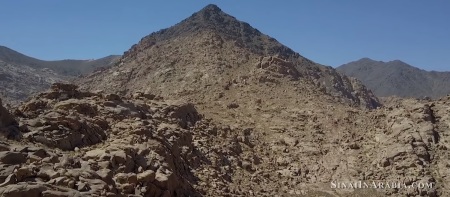Viral online film argues Exodus went into Saudi Arabia, Mt. Sinai located in Muslim nation

A new online documentary video has argued that Moses and the Hebrews went into Saudi Arabia during the Exodus, with the famous Mt. Sinai being in the Arabian Peninsula.
Ryan Mauro, a national security expert, director of the Clarion Intelligence Network and former professor at Liberty University, uploaded a nearly 25-minute long film to YouTube on Dec. 17.
Created with The Doubting Thomas Research Foundation, Mauro’s film argues that Mt. Sinai is the modern day Jebel al-Lawz.
“For generations, we have been taught we had to believe the story of the Exodus on faith alone. We were taught that Mount Sinai was located in Egypt's Sinai Peninsula, but there was barely any evidence found there to make the story of Moses and the Exodus believable,” reads the video’s description.
“A new theory has emerged in recent decades that the real Mount Sinai is actually in Saudi Arabia, along with other stunning evidences … Now, unprecedented footage has been acquired from within Saudi Arabia, bringing the Exodus story to life as never before and potentially shaking up the Middle East.”
Mauro narrates the video, interviewing multiple individuals ranging from a former member of a Jihadist organization to an American pilot who served in the Second World War, who argue that the Saudi Arabian mountain is the biblical Mt. Sinai.
He points to evidence such as a shallow underwater land bridge, called the “Nuweiba Land Bridge,” leading from Egypt to the Arabian Peninsula that could have been used by the Hebrews when, according the biblical account of the Exodus, the Red Sea parted.
Mauro also noted that the area around Jebel al-Lawz included some archaeological evidence indicating an ancient Jewish presence, such as artwork depicting a Menorah and calves.
According to Mauro, the area is fiercely guarded by Saudi officials and is hard to access. There are also plans by the Saudi government to construct a major city in the area, threatening the site and any further evidence that could be discovered.
“The Saudis are constructing a super-city that is planned to be 33 times the size of New York. If all of us don’t take action, Saudi construction in the area may destroy key evidence and prevent excavation for the foreseeable future,” Mauro said in the video.
To try and stop the construction project, Mauro has helped set up a website called sinaiinarabia.com, as well as a nonprofit, to spread awareness.
The claim that Saudi Arabia has the real Mt. Sinai has been around for the past several years, going at least as far back as the 1980s and has many critics.
Gordon Franz, a Bible teacher who holds an MA in Biblical Studies from Columbia Biblical Seminary, is one of the critics of the Exodus-Saudi Arabia theory.
In a paper published on Biblical Archaeology’s website in 2007, Franz argued that “there is no credible historical, geographical, archaeological or Biblical evidence to support the thesis that Mt. Sinai is at Jebel al-Lawz in Saudi Arabia.”
In his lengthy paper, Franz pointed to apparent contradictions between how the Bible described the Exodus and the features of the alleged Saudi Arabian site. He also noted chronological issues with some of the on-the-ground evidence purporting to show that Moses and the Ancient Israelites went into the area.
“First, the Sinai Peninsula was not part of Egypt proper, but “out of Egypt.” Second, Biblically, Mt. Sinai is not in the Land of Midian, yet Jebel al-Lawz is in Midian territory (northwest Saudi Arabia),” wrote Franz.
“The proponents also need to face up to the archaeological evidence at their site. The petroglyphs of bovine existed long before Moses ever lived. The so-called ‘Cave of Moses’ at el-Bad’ were not hewn until long after Moses lived.”
Franz also explained that the Nuweiba land crossing was problematic as the terrain of the underwater bridge would have been challenging for the Hebrews to cross, especially in the time explained by the Bible.
“From Nuweiba the land bridge slopes down to 850 meters (2,790 feet) but then comes up sharply on the east side as it gets to the shore of Saudi Arabia. This sharp incline would make the ascent extremely difficult, if not impossible for the Israelites to cross in one night,” noted Franz.






















